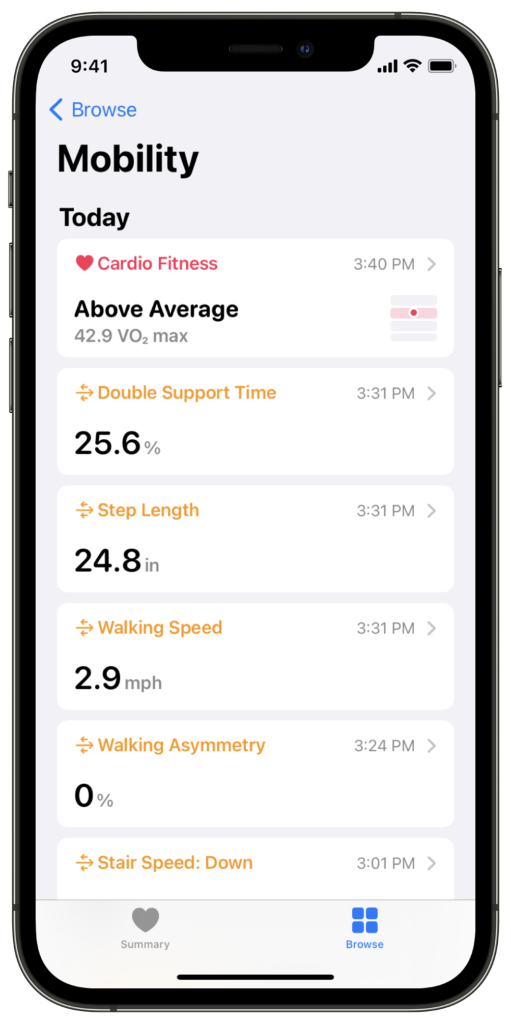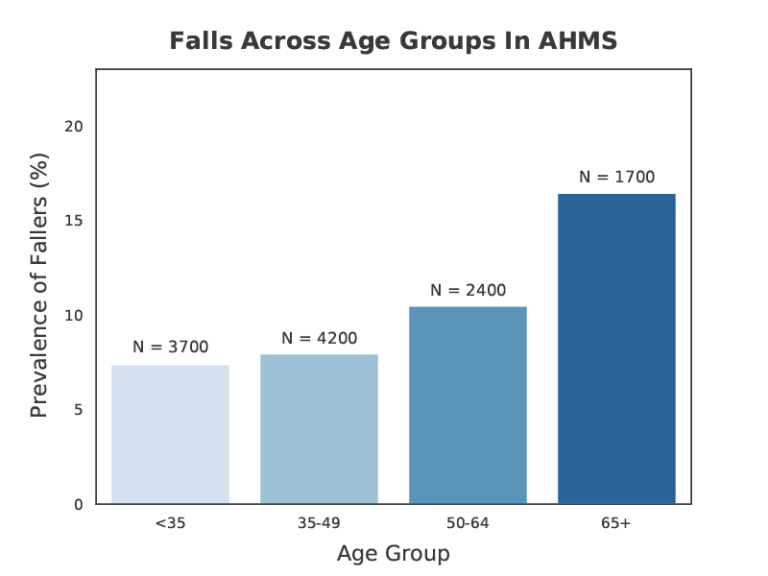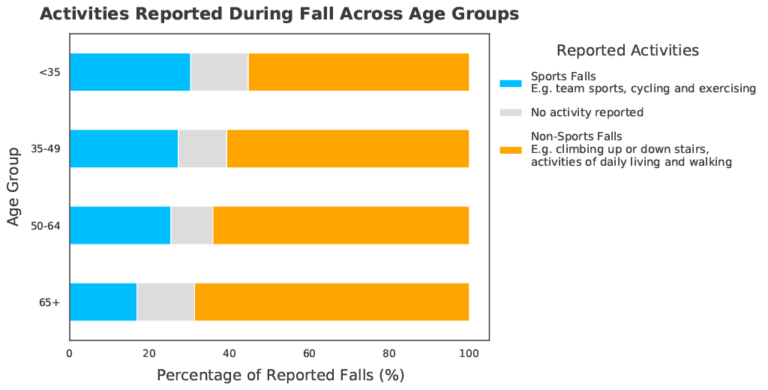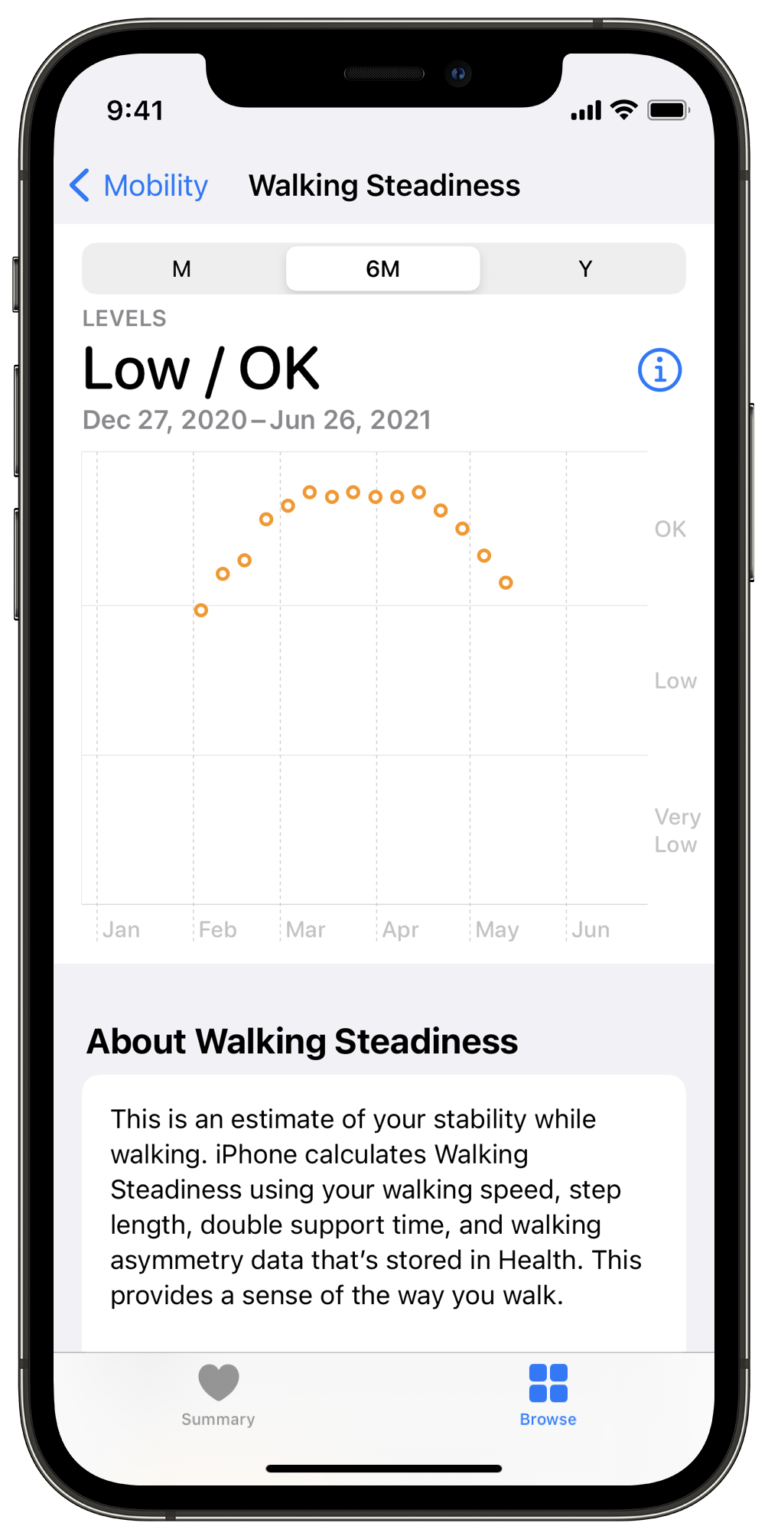September 22nd is National Fall Prevention Awareness Day in the U.S. In honor of this, the study team wanted to provide information about how your contributions to Apple Heart and Movement Study (AHMS) are helping detect and prevent falls.
Why is studying falls important?
Falls are a significant problem for older adults (those 65 and older), and there’s no shortage of data demonstrating this. In a given year, one out of every four older adults falls [1]. According to the Centers for Disease Control (CDC), these falls result in over 8 million injuries and cost about $50 billion each year in the United States [2]. Globally, deaths from falls doubled between 1990 and 2017 [3].
Researchers haven’t examined falls as extensively in younger age groups, and fall detection and prevention remain challenging. On your Apple Watch, you may have Fall Detection enabled, and your iPhone can measure Mobility Metrics (Figure 1). By sharing these metrics in combination with other data, AHMS participants are helping improve our understanding of falls and fall risks and helping us build solutions to address these problems

How this study helps us better understand falls
If you’re participating in AHMS, about a month after enrollment you were asked to complete a questionnaire assessing risk factors for falling. This questionnaire is part of the CDC’s Stopping Elderly Accidents, Deaths & Injuries initiative and is commonly used to assess fall risk. Additional questions about mobility, activity, and health history also help us understand why some people may be more prone to falls.
Within the Research app, beyond scheduled survey questions, AHMS may prompt an additional survey when your Apple Watch detects a possible fall. This is to verify if you’ve had a recent single fall or multiple falls, and, if you did, to provide details about the circumstances. Based on your response, you may even be asked if you’re willing to speak with study staff by phone to provide more details about a fall.
Counting falls (and calls)
Since AHMS started in November 2019, study participants have provided information about more than 12,000 falls. The research team at Brigham and Women’s Hospital also recently completed their 1,000th call to gather more detailed information about falls that occurred during the study.
The graphs below show that people of all ages groups studied fall (Figure 2) and that these falls occur during many different activities, regardless of age (Figure 3). This helps reinforce that falls and fall risk are important topics for people of all ages.


Walking Steadiness and your contributions
The information gathered through AHMS and other studies has provided teams at Apple with more information about mobility and falls, helping them to build a new metric, Walking Steadiness, available in iOS 15 on iPhone 8 and later. Walking Steadiness incorporates multiple measures of how you walk, all collected from sensors on your iPhone, and provides a score of OK, Low, or Very Low (Figure 4).

A Walking Steadiness of Low or Very Low indicates an increased risk of falling over the next 12 months. This information gives people a chance to take preventive action (such as exercises focused on strength and balance after consulting with their physician) before they’ve had a fall. Contributions from AHMS participants made Walking Steadiness possible, so we owe each study participant a huge thanks for helping us increase our understanding of fall risk and hopefully preventing falls before they happen.
The future…
We hope this serves as a powerful example of how participating in research helps researchers better understand health events and complex topics like risk of falling. Research can be most impactful when the understanding gained leads to innovation that helps people beyond those who participate in a study such as AHMS.
You’ll continue to receive questions (some on a regular schedule and some, like those about falls, that may be triggered by possible events) and you still may be asked to speak to someone from the study team by phone. Please continue to review and complete new tasks, and remember you can update your notification settings for the Research app at any time to be reminded of available study tasks that help contribute to this research. Your continued participation over time is critically important as it helps us understand which factors and common behaviors may be associated with events like falls and what may protect people from these events in the future.
For all those participating in AHMS – thank you for your time, your answers to questions, the conversations, and thank you for helping to improve how we understand falls and fall risk.
References
[1] Bergen G, Stevens MR, Burns ER. Falls and Fall Injuries Among Adults Aged ≥65 Years — United States, 2014. Mmwr Morbidity Mortal Wkly Rep. 2016;65(37):993-998. doi:10.15585/mmwr.mm6537a2
[2] https://www.cdc.gov/homeandrecreationalsafety/falls/adultfalls.html. Accessed August, 11, 2021.
[3] James SL, Lucchesi LR, Bisignano C, et al. The global burden of falls: global, regional and national estimates of morbidity and mortality from the Global Burden of Disease Study 2017. Injury Prev. 2020;26(Supp 1). doi:10.1136/injuryprev-2019-043286
